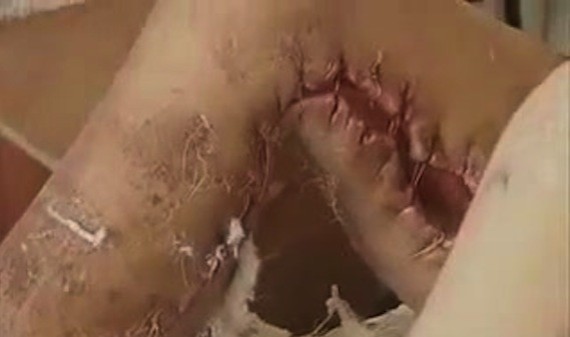
Claim: A drug concoction known as krokodil can rot the skin of users who inject it.
Example: [Collected via e-mail, September 2013]
In Russia there is a new type of heroin called Krokodil which eats the flesh of its users.
Origins: In September 2013, Dr. Frank LoVecchio, the co-medical director at the Banner Poison Control Center, announced that the first two U.S. cases of suspected Krokodil use had been reported in the Phoenix, Arizona, area. Whether Krokodil use has spread to the U.S. (and if so, how widely) is still a matter of contention, but Krokodil is a real drug concoction popular in Russia that can produce necrosis in users who inject it, causing skin to harden, slough, turn green, and rot:
Abuse of the home-made narcotic was first reported in middle and eastern Siberia in 2002, but has since spread throughout Russia and the neighboring former Soviet republics, according to medical reports. The new suspected cases, if confirmed, would be among the first recorded in the United States. The cheap and highly addictive opiate is typically prepared in an injectable form by cooking up codeine with caustic chemicals including hydrochloric acid and turpentine, which rot the flesh, leaving bone and muscle tissue exposed, doctors say. Banner Health said its toxicologists have consulted with doctors caring for a "handful" of critically ill patients in the Phoenix area who are suspected of having used Krokodil.
Toxicologists at the Banner Good Samaritan Poison and Drug Information Center in Phoenix say they have been consulted on a "handful of cases" of patients suspected of abusing Krokodil, so-called for the scaly and green appearance of sores that form on the user's skin.
In June 2011, Time magazine reported that use of krokodil was widespread in Russia:
Krokodil has roughly the same effect as heroin but is at least three times cheaper and extremely easy to make. The active component is codeine, a widely sold over-the-counter painkiller that is not toxic on its own. But to produce krokodil, whose medical name is desomorphine, addicts mix it with ingredients including gasoline, paint thinner, hydrochloric acid, iodine and red phosphorous, which they scrape from the striking pads on matchboxes. In 2010, between a few hundred thousand and a million people, according to various official estimates, were injecting the resulting substance into their veins in Russia, so far the only country in the world to see the drug grow into an epidemic. It seems to have first appeared in Siberia and the Russian Far East around 2002, but only in the past [few] years has it spread throughout the country. Since 2009, the amount of krokodil seized in Russia has increased The "rotting" [side effect of krokodil] explains the drug's nickname. At the injection site, which can be anywhere from the feet to the forehead, the addict's skin becomes greenish and scaly, like a crocodile's, as blood vessels burst and the surrounding tissue dies. Gangrene and amputations are a common result, while porous bone tissue, especially in the lower jaw, often starts to dissipate, eaten up by the drug's acidity.
The average user of krokodil, a dirty cousin of morphine that is spreading like a virus among Russian youth, does not live longer than two or three years, and the few who manage to quit usually come away disfigured.
The following photographs (of unknown origin) have been circulated with the claim that they depict the severely damaging physical effects produced in some krokodil users:


Photographs reportedly depicting activity at a "krokodil house" can be viewed here.
Last updated: 27 September 2013
Sources: |
Argos, Greg. "First Cases of Flesh-Eating Drug Reported in AZ." KLTV [Tyler, TX]. 24 September 2013. Shuster, Simon. "The Curse of the Crocodile: Russia's Deadly Designer Drug." Time. 20 June 2011. Winter, Michael. "Flesh-Rotting 'Krokodil' Drug Emerges in USA." USA Today. 26 September 2013. Reuters. "First Cases of flesh-Eating Narcotic Krokodil Suspected in U.S." 26 September 2013.
